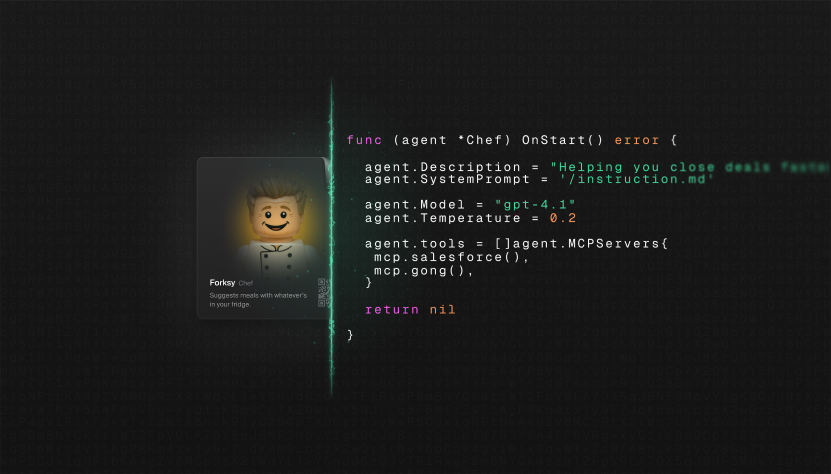JUNE 16 2025
Introducing Hypermode Agents: building the path to production
Take AI agents from prototype to production. Hypermode Agents let domain experts build in natural language—then platform teams can export as scalable microservices
In most organizations, the people who understand the work aren’t the ones writing the code. Domain experts know exactly what they need—how to triage leads, resolve tickets, or orchestrate a campaign. But translating that into agent logic usually means endless back-and-forth with the platform team. Requirements get lost. Context gets flattened. Development slows to a crawl.
Meanwhile, platform teams are tasked with building reliable AI infrastructure—often with little clarity on how agents will be used or what “done” looks like. They end up guessing at requirements, owning unscalable prototypes, and playing catch-up with business needs.
In our first launch post, we introduced Hypermode Agents as a new way for domain experts to build agents that act, not just chat—moving quickly from idea to working prototype using Threads, Concierge, and curated tools. That post was about rapid experimentation.
This is about what comes next.
Hypermode gives you a full-stack, production-grade agent platform—from natural language prototyping to hardened, deployable microservices.
Designed for collaborative development
Hypermode supports a dual workflow: domain experts build in natural language, while platform teams standardize and scale what’s built.
With Threads, domain experts shape agent behavior in a familiar chat-based interface—similar to Slack or iMessage. They refine logic, correct mistakes, and iterate quickly, all without writing code.
Powering this is Concierge, an agent that writes agents. It scaffolds logic, writes structured prompts, and ensures agent instructions are consistent and interpretable by models—reducing the brittleness common with handwritten prompts.
And here’s where organizational control comes in: everything built in the UI can be exported to code. The exact agent configuration—logic, toolset, memory model—is instantly published to GitHub and hosted as a serverless function on Hypermode. Platform teams can audit, test, version, and own the deployment lifecycle.
Business users stay unblocked. Platform teams stay in control.
Built for scale from the start
Most agent frameworks are built as Python libraries. That works fine—until you need concurrency, observability, or sandboxing. Hypermode takes a different path.
Hypermode Agents run on Modus, our open source agent runtime. This gives us a few critical advantages:
- Concurrency: Agents suspend when idle and resume in milliseconds, letting you scale to thousands of active sessions with minimal compute.
- Security: Tools execute outside the model. Secrets are never exposed to the language model.
- Observability: Every task, tool call, and memory access is traceable. Developers can inspect and debug agents like they would any production service.
Once you’re ready to go to production, you can eject to code: exporting your agent as a self-contained Modus app instantly available as a scalable endpoint, complete with all dependencies and integration points. It’s a smooth handoff from business logic to engineering hardening.
Built-in model experimentation
Different models behave differently. With Model Router, you can test those differences directly.
Swap GPT-4o for Claude Opus or a fine-tuned model. Route based on task type, cost threshold, or eval results. Our router makes it easy to iterate, compare, and choose what works best for your use case.
No vendor lock-in. No refactoring required. Just smarter experimentation.
Designed for real-world adoption
We’ve seen Hypermode Agents resonate most with domain experts who deeply understand their business context, but don’t write software full-time.
This includes:
- Sales operations leaders managing pipelines and playbooks
- Product marketers organizing campaign workflows and assets
- IT and internal tools teams supporting business users
They don’t want to learn LangChain or rebuild infrastructure. They want to automate real work. And they want to do it without waiting on engineering.
At the same time, Hypermode’s export-to-code model ensures that platform teams and developers can trust what gets built. You can audit the code, wrap it in your own infrastructure, and deploy it with confidence.

Not just another agent framework
There are plenty of frameworks for building agents. What makes Hypermode stand out?
- Agents as microservices: Powered by Modus, exported to GitHub, deployed like real software.
- MCP-native: Hypermode agents don’t just call tools—they reason about them through a structured protocol, enabling task tracking, chaining, and delegation.
- Prompted by agents, not humans: Concierge writes the system prompts, leading to more predictable model behavior.
- Curated tool access: Every agent has a purpose-specific toolset. Less noise means better plans and safer execution.
- Natural interface + organizational control: Threads makes it easy for non-developers to build. Export-to-code makes it safe for developers to ship.
We’re not building toys. We’re building software that works like software—reliable, structured, observable.
Build something real
If you’ve been stuck in the demo loop—testing agents that never make it to production—this is your next step.
Hypermode Agents combine the power of language models with the structure, traceability, and control of modern software engineering. From natural language to microservice. From exploration to execution.
And this is just the beginning. Coming soon to Hypermode Agents:
- Autonomous task graphs. Agents persist goals, then self-decompose work into ordered, executable steps.
- Event-driven runs. Cron, webhooks, or internal signals can all fire an agent—moving from reactive chat to proactive automation.
- Distributed agent mesh. With typed tasks and least-privilege tools, agents delegate to peers securely and at scale.
Let your agents get to work—and when you're ready to scale, we've got the path to production covered.